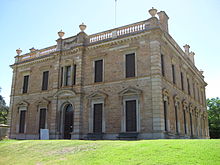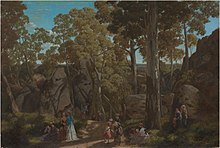Picnic on Valentine's Day
| Movie | |
|---|---|
| German title | Picnic on Valentine's Day |
| Original title | Picnic at Hanging Rock |
| Country of production | Australia |
| original language | English |
| Publishing year | 1975 |
| length | 115 minutes |
| Age rating | FSK 12 |
| Rod | |
| Director | Peter Weir |
| script | Cliff Green |
| production |
Patricia Lovell , Hal and Jim McElroy , A. John Graves |
| music |
Bruce Smeaton , Gheorghe Zamfir |
| camera | Russell Boyd |
| cut | Max Lemon |
| occupation | |
| |
Picnic on Valentine's Day (Original title: Picnic at Hanging Rock ) is an Australian feature film by Peter Weir from 1975, which is based on the novel by Joan Lindsay . As one of the first Australian films to find an international audience and thus helped Australian film its international breakthrough, it was valued by critics and viewers alike, and is now considered one of the milestones of Australian cinema. The premiere took place on August 8, 1975 in Adelaide . The film was released in Germany on July 24, 1977.
action
1900, in the Australian state of Victoria : The widow Mrs. Appleyard leads the girls' boarding school Appleyard College near the small town of Woodend with a hard hand . On Valentine's Day , the students set off on a horse-drawn carriage ride on Hanging Rock with the educated math teacher Miss McCraw and the young, friendly French teacher Dianne de Poitiers . Also present on this day is the young Englishman Michael Fitzhubert, who, together with the family servant Albert, observes how the four girls Miranda, Marion, Irma and Edith move away from the rest of the group. The four girls reach the top of the Hanging Rock via branched paths and lie there in the sun. Suddenly Miranda, Marion and Irma move behind a ledge as if in a trance . The three do not respond to Edith's calls, who screams desperately and runs back to the other students. But not only the three students, Miss McCraw has also disappeared without a trace - Edith remembers that the teacher met her when she escaped from the top of the hanging rock and did not wear a petticoat .
Several searches by the local police are unsuccessful, and the reason for their disappearance cannot be determined. Michael Fitzhubert developed an increasing obsession with the case and especially with the exceptionally beautiful Miranda, whereupon he stayed overnight at Hanging Rock on his own, doing investigations. The next morning the servant found Albert Michael slumped and with a wound on his forehead on the rock. Before he is taken away by the doctor, Michael gives Albert a scrap of cloth that matches the clothes of the girls at the boarding school. In fact, Albert goes to the Hanging Rock to search for it and finds Irma unconscious but alive. Despite the week since disappearing, she shows no serious injuries, but like Michael she has a wound on her forehead.
The unexpected appearance of Irma electrifies the citizens and the press. The other three women cannot be found despite further searches, and a funeral service is held for them. Michael and later the other students at the boarding school ask Irma to clarify the case, but she doesn't seem to be able to remember anything. The other students don't believe Irma and attack her. Irma is eventually sent back to her relatives in England.
The incidents at Hanging Rock and the speculation that followed are the starting point for the decline of the girls' school: more and more parents are de-registering their girls, the teacher Miss Lumley quits, and Mrs. Appleyard is addicted to alcohol. The schoolgirl and orphan Sara, who was not allowed to be on the excursion, thinks Miranda is a prophetess and idolizes her. She believes in a supernatural disappearance. Since Sara is a thorn in her side and her school fees are long overdue anyway, Mrs. Appleyard announces that she must be sent back to the orphanage. The next day the gardener finds Sara dead, judging by her injuries she threw herself out of a window and into her death. Earlier, Mrs. Appleyard had lied to Miss de Poitiers that Sara had already left. Meanwhile, Albert tells Michael that his sister Sara - with whom he once grew up in the orphanage and whose whereabouts he knows nothing about - appeared to him in a dream.
Mrs. Appleyard is found a little later in front of the Hanging Rock - whether it was a suicide or an accident remains unclear. The disappearance of Miss McCraw and the two schoolgirls remains equally unexplained, despite sporadic searches over the next few years.
background
With the Australian Film Commission, McElroy & McElroy, British Empire Films, Picnic Productions Ltd and the South Australian Film Corporation, a total of five production companies were ultimately involved in Picnic on Valentine's Day , even though the budget of the film was only 440,000 Australian dollars . The shooting took place from February 1975 over a period of six weeks. Casting the girl roles proved challenging as Weir desperately wanted actresses who had a Victorian look. Ultimately, he found many of the actresses in rural South Australia.
Two decades later, Peter Weir made a director's cut of the film, which was first released on DVD by the Criterion Collection in 1998 and is also used in subsequent German DVD and Blu-Ray editions of the film. The Director's Cut removes around eight minutes and adds a minute of new footage, reducing the running time around seven minutes. The omitted scenes focus in particular on the relationship between Irma and Michael, who asks her about the events on Valentine's Day and between which a romantic tension arises for a short time, but which in the end does not lead in any important direction in terms of plot. The reason for the cut was that the scenes would have seemed too obvious to the viewer, without these scenes the film would now appear more stringent in the Director's Cut. Anne Louise-Lambert, who played Miranda, criticized the fact that once the director had released the film to the public, it should belong to the public, as some of the scenes that were now removed were much loved. The omitted scenes from the Director's Cut are included in most DVD and Blu-Ray editions of the film as bonus material.
Film music
You can hear Beethoven's 5th Piano Concerto , A Little Night Music by Wolfgang Amadeus Mozart and the Welsh military march Men of Harlech . For the film, Gheorghe Zamfir recorded the compositions Doina Lui Petru Unc and Doina: Sus Pe Culmea Dealului on the panpipe . The Australian film composer Bruce Smeaton wrote additional original music (known as "The Ascent Music") for the key scene of the ascent to Hanging Rock .
Reviews

"Despite some lengths and melodramatic flourishes, the film captivates with a strong tension, especially in the first part."
“Peter Weir's Valentine's Day Picnic is a film about a gripping mystery that is riddled with suppressed sexual hysteria. He uses two trademarks of modern Australian film: beautiful cinematography and stories about the gap between the European settlers and the mysteries of ancient Australia. "
“Horror doesn't necessarily come in the form of a gentleman in evening clothes with long canine teeth, a mutilated corpse, or a doctor with a brain in a fishbowl. It can also happen on a sunny day, when childlike innocence and hints of an unexplored sexuality combine to create an intense euphoric mood that puts you in a state beyond life or death. Such horror is unspeakable, not because it is so terrible, but because it remains elusive and defies conventional explanations and definitions. "
" Valentine's Day Picnic remains the film with which the name Peter Weir is most closely associated, and it continues to be one of the milestones of Australian cinema. It made Peter Weir internationally known and ushered in a renaissance of Australian film."
literature
- Joan Lindsay : Picnic on Valentine's Day. Roman (original title: Picnic at Hanging Rock ). German by Werner Wolf. With an afterword by Florian F. Marzin. Unabridged edition. Deutscher Taschenbuch-Verlag (dtv), Munich 2004, 284 pages, ISBN 3-423-20687-X
- Jonathan Rayner: Contemporary Australian Cinema: An Introduction . Manchester University Press 2000, ISBN 0-7190-5327-7 , pp. 63-70
- Ed Roginski: Picnic at Hanging Rock by Peter Weir . Film Quarterly, Vol. 32, No. 4, summer 1979, pp. 22-26 ( JSTOR 1211956 )
Web links
- Picnic at Hanging Rock in the Internet Movie Database (English)
- Picnic at Hanging Rock at Rotten Tomatoes (English)
- Picnic at Hanging Rock in the Criterion Collection (English)
- Comparison of the Director's Cut - Theatrical Version of Picnic on Valentine's Day at Schnittberichte.com
- Luke Buckmaster: Picnic at Hanging Rock: Rewatching classic Australian films at www.theguardian.com
- Michelle Griffin: In search of Picnic's past . The Age, November 20, 2002
Individual evidence
- ↑ Release certificate for a picnic on Valentine's Day . Voluntary self-regulation of the film industry , April 2004 (PDF; test number: 73 530 V / DVD).
- ↑ Picnic at Hanging Rock (1975) - IMDb Company. Retrieved April 3, 2019 .
- ^ David Stratton: The Last New Wave: The Australian Film Revival , Angus & Robertson, 1980, pp. 68-69.
- ^ Serena Formica: Peter Weir: A Creative Journey from Australia to Hollywood . Intellect Books, 2012, ISBN 978-1-84150-477-3 ( google.de [accessed April 3, 2019]).
- ^ David Harley: Picnic at Hanging Rock (R2). In: Bloody Disgusting! Retrieved June 24, 2008, April 3, 2019 (American English).
- ^ David Harley: Picnic at Hanging Rock (R2). In: Bloody Disgusting! Retrieved June 24, 2008, April 3, 2019 (American English).
- ↑ MrUndersky: About the Director's cut of Picnic at Hanging Rock. March 6, 2014, accessed April 3, 2019 .
- ↑ Soundtrack. IMDb ; Retrieved February 11, 2009.
- ↑ Picnic on Valentine's Day. In: Lexicon of International Films . Film Service , accessed February 11, 2009 .
- ↑ Roger Ebert's film review on Valentine's Day Picnic
- ↑ Vincent Canby in the New York Times, February 23, 1979
- ↑ Jonathan Rayner: The Films of Peter Weir . Continuum International Publishing Group 2006, ISBN 0-8264-1908-9 , p. 59 ( limited online version (Google Books) )
